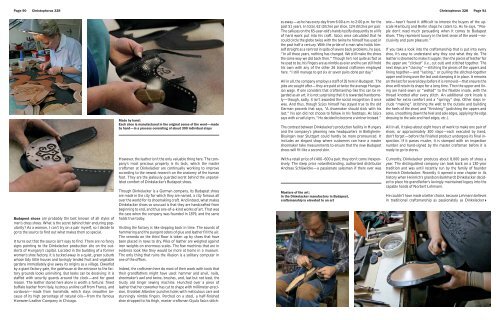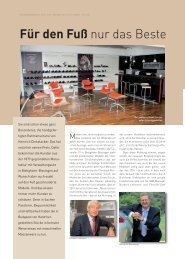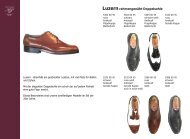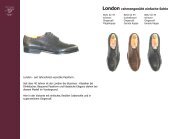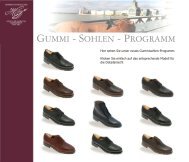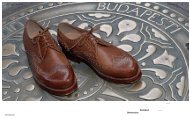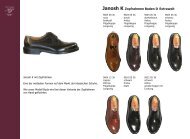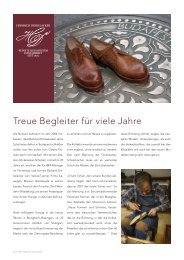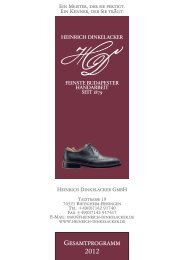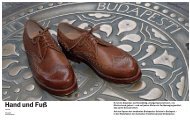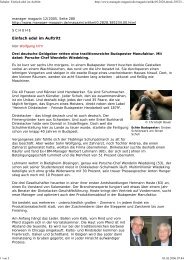The Beauty of Budapest - Heinrich Dinkelacker GmbH
The Beauty of Budapest - Heinrich Dinkelacker GmbH
The Beauty of Budapest - Heinrich Dinkelacker GmbH
Create successful ePaper yourself
Turn your PDF publications into a flip-book with our unique Google optimized e-Paper software.
Page 90<br />
Christophorus 328<br />
Christophorus 328<br />
Page 91<br />
Made by hand:<br />
Each shoe is manufactured in the original sense <strong>of</strong> the word—made<br />
by hand—in a process consisting <strong>of</strong> about 300 individual steps<br />
es away—as he has every day from 6:00 a.m. to 2:00 p.m. for the<br />
past 51 years. In total, 62 stitches per shoe, 124 stitches per pair.<br />
<strong>The</strong> calluses on the 65-year-old’s hands testify eloquently to a life<br />
<strong>of</strong> hard work put into his craft. Szücs once calculated that he<br />
could circle the globe twice with the twine he himself has used in<br />
the past half a century. With the pride <strong>of</strong> a man who holds himself<br />
straight as a ramrod in spite <strong>of</strong> severe back problems, he says,<br />
“In all those years, nothing has changed. We still make the shoes<br />
the same way we did back then.” Though he’s not quite as fast as<br />
he used to be, his fingers are as nimble as ever and he can still hold<br />
his own with any <strong>of</strong> the other 26 trained craftsmen employed<br />
here. “I still manage to get six or seven pairs done per day.”<br />
All in all, the company employs a staff <strong>of</strong> 35 here in <strong>Budapest</strong>. <strong>The</strong><br />
jobs are sought after—they are paid at twice the average Hungarian<br />
wage. If one considers that craftsmanship like this can be regarded<br />
as an art, it is not surprising that it is rewarded handsomely—though,<br />
sadly, it isn’t awarded the social recognition it once<br />
was. And thus, though Szücs himself has stayed true to the old<br />
German proverb that says, “A shoemaker should stick with his<br />
last,” his son did not choose to follow in his footsteps. As Szücs<br />
says with a rueful grin, “He decided to become a vintner instead.”<br />
<strong>The</strong> contrast between <strong>Dinkelacker</strong>’s production facility in Hungary<br />
and the company’s gleaming new headquarters in Bietigheim-<br />
Bissingen near Stuttgart could hardly be more pronounced. It<br />
includes an elegant shop where customers can have a master<br />
shoemaker take measurements to ensure that the new <strong>Budapest</strong><br />
shoes will fit like a second skin.<br />
one—hasn’t found it difficult to interest the buyers <strong>of</strong> the upscale<br />
Hamburg and Berlin shops he caters to. As he says, “People<br />
don’t need much persuading when it comes to <strong>Budapest</strong><br />
shoes. <strong>The</strong>y represent luxury in the best sense <strong>of</strong> the word—exclusivity<br />
and pure pleasure.”<br />
If you take a look into the craftsmanship that is put into every<br />
shoe, it’s easy to understand why they cost what they do. <strong>The</strong><br />
leather is steamed to make it supple; then the pieces <strong>of</strong> leather for<br />
the upper are “clicked” (i.e., cut out) and stitched together. <strong>The</strong><br />
next steps are “closing”—stitching the pieces <strong>of</strong> the uppers and<br />
lining together—and “lasting,” or pulling the stitched-together<br />
upper and lining over the last and clamping it in place. It remains<br />
on the last for several days before it is removed—that ensures the<br />
shoe will retain its shape for a long time. <strong>The</strong>n the upper and lining<br />
are hand-sewn or “welted” to the flexible insole, with the<br />
thread knotted after every stitch. An additional cork insole is<br />
added for extra comfort and a “springy” step. Other steps include<br />
“making” (stitching the welt to the outsole and building<br />
the heels <strong>of</strong> the shoe) and “finishing” (polishing the uppers and<br />
soles, smoothing down the heel and sole edges, applying the edge<br />
dressing to the sole and heel edges, etc.).<br />
All in all, it takes about eight hours <strong>of</strong> work to make one pair <strong>of</strong><br />
shoes, or approximately 300 steps—each executed by hand,<br />
don’t forget—before the finished product undergoes its final inspection.<br />
If it passes muster, it is stamped with an inspection<br />
number and hand-signed by the master craftsman before it is<br />
ready to go to stores.<br />
<strong>Budapest</strong> shoes are probably the best known <strong>of</strong> all styles <strong>of</strong><br />
men’s dress shoes. What is the secret behind their enduring popularity?<br />
As a woman, I can’t try on a pair myself, so I decide to<br />
go to the source to find out what makes them so special.<br />
It turns out that the source isn’t easy to find. <strong>The</strong>re are no fancy<br />
signs pointing to the <strong>Dinkelacker</strong> production site on the outskirts<br />
<strong>of</strong> Hungary’s capital. Located in the building <strong>of</strong> a former<br />
women’s shoe factory, it is tucked away in a quiet, green suburb<br />
whose tidy little houses and lovingly tended fruit and vegetable<br />
gardens immediately give away its origins as a village. Dwarfed<br />
by a giant factory gate, the gatehouse at the entrance to the factory<br />
grounds looks uninviting. But looks can be deceiving: it is<br />
staffed with security guards around the clock—and for good<br />
reason. <strong>The</strong> leather stored here alone is worth a fortune: finest<br />
buffalo leather from Italy, lustrous aniline calf from France, and<br />
cordovan—made from horsehide, which stays smoother because<br />
<strong>of</strong> its high percentage <strong>of</strong> natural oils—from the famous<br />
Horween Leather Company in Chicago.<br />
However, the leather isn’t the only valuable thing here. <strong>The</strong> company’s<br />
most precious property is its lasts, which the master<br />
craftsmen at <strong>Dinkelacker</strong> are continually working to improve<br />
according to the newest research on the anatomy <strong>of</strong> the human<br />
foot. <strong>The</strong>y are the jealously guarded secret behind the unparalleled<br />
comfort <strong>of</strong> <strong>Dinkelacker</strong>’s <strong>Budapest</strong> shoes.<br />
Though <strong>Dinkelacker</strong> is a German company, its <strong>Budapest</strong> shoes<br />
are made in the city for which they are named, a city famous all<br />
over the world for its shoemaking craft. And indeed, what makes<br />
<strong>Dinkelacker</strong> shoes so unusual is that they are handcrafted from<br />
beginning to end, and thus one-<strong>of</strong>-a-kind works <strong>of</strong> art. That was<br />
the case when the company was founded in 1879, and the same<br />
holds true today.<br />
Visiting the factory is like stepping back in time. <strong>The</strong> sounds <strong>of</strong><br />
hammering and the pungent odors <strong>of</strong> glue and leather fill the air.<br />
<strong>The</strong> veranda on the third floor is taken up by shoes that have<br />
been placed in rows to dry. Piles <strong>of</strong> leather are weighed against<br />
iron weights on enormous scales. <strong>The</strong> few machines that are in<br />
evidence look like they would be more at home in a museum.<br />
<strong>The</strong> only thing that ruins the illusion is a solitary computer in<br />
one <strong>of</strong> the <strong>of</strong>fices.<br />
Indeed, the craftsmen here do most <strong>of</strong> their work with tools that<br />
their grandfathers might have used: hammer and anvil, nails,<br />
shoemaker’s awl and twine, brushes, and, last but not least, the<br />
trusty old Singer sewing machine. Hunched over a piece <strong>of</strong><br />
leather that her coworker has cut to shape with millimeter-precision,<br />
Erzsébet Albecker punches holes with meticulous care and<br />
stunningly nimble fingers. Perched on a stool, a half-finished<br />
shoe strapped to his thigh, master craftsman Gyula Szücs stitch-<br />
With a retail price <strong>of</strong> ¤400–600 a pair, they don’t come inexpensively.<br />
<strong>The</strong> steep price notwithstanding, authorized distributor<br />
Andreas Schläwicke—a passionate salesman if there ever was<br />
Masters <strong>of</strong> the art:<br />
In the <strong>Dinkelacker</strong> manufactory in <strong>Budapest</strong>,<br />
craftsmanship is elevated to an art<br />
Currently, <strong>Dinkelacker</strong> produces about 8,000 pairs <strong>of</strong> shoes a<br />
year. <strong>The</strong> distinguished company can look back on a 130-year<br />
tradition and was until recently run by the family <strong>of</strong> founder<br />
<strong>Heinrich</strong> <strong>Dinkelacker</strong>. Recently it opened a new chapter in its<br />
history when <strong>Heinrich</strong>’s grandson Burkhardt <strong>Dinkelacker</strong> decided<br />
to place his grandfather’s lovingly maintained legacy into the<br />
capable hands <strong>of</strong> Norbert Lehmann.<br />
He couldn’t have made a better choice, because Lehmann believes<br />
in traditional craftsmanship as passionately as <strong>Dinkelacker</strong> A


